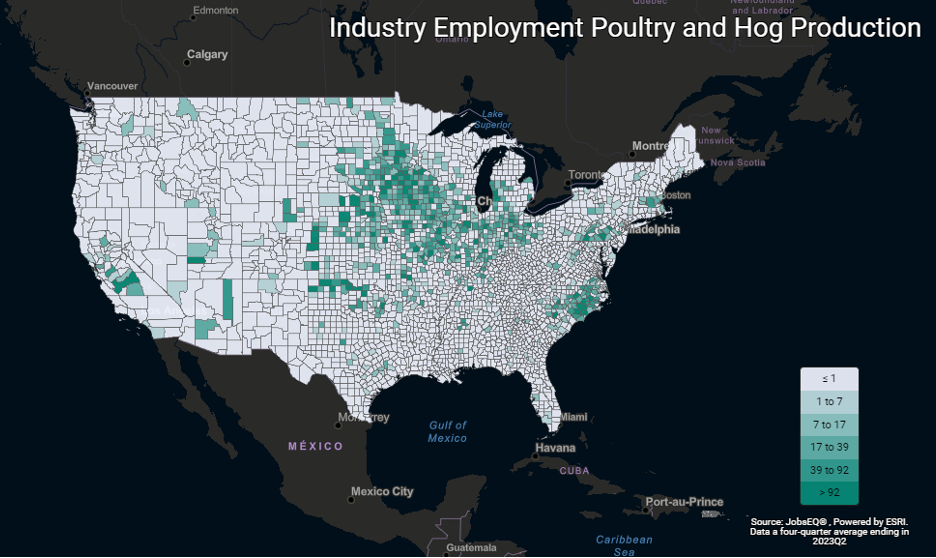A Time To Be Thankful: Some Relief Expected for Your Holiday Meal

By Former Chmura Staff |
We are officially rolling into the holiday season. Grocery stores are stocking shelves and households are preparing for Thanksgiving. Despite an adequate supply of turkeys this year, we’re still seeing some costs for our favorite holiday foods impacted by environmental, labor, and supply chain factors. Accounting for the full spread on the Thanksgiving table, the positive news is that costs should be slightly cheaper than in 2022.
Bloomberg cites the cost of canned goods has increased, meaning those canned cranberries are up 60%.[1] Additionally, canned pumpkin has been impacted by an increase in price. Outside of canned goods, cream and milk are facing a tight supply market across the United States. Even with the ample supply of turkeys, ham costs are increasing from last year. Green beans, both fresh and canned, are seeing price increases this year in supermarkets - these regular staples are integral to our traditional Thanksgiving spread.
U.S. Farm Bureau published its annual cost of Thanksgiving dinner on November 15.[2] While the cost of some sides and desserts will see an increase in price, overall, the estimated total cost is down 4.5% from last year. The reason for this drop is a 5.5% decline in the price of turkey which accounts for almost half of the cost of Thanksgiving dinner. Although prices are down from last year, a Thanksgiving dinner is still 30% more expensive than three years ago.[3]

With the rest of the holiday season on the horizon, savvy shoppers can consider some cost savings. Fresh cranberries are anticipated to drop 20% year over year. Buying fresh instead of prepared meals will help cut costs for anyone who needs to save at the checkout.
According to the latest U.S. Foods Farmers Report, green beans, asparagus, broccoli, and cauliflower are all anticipated to have supply issues leading into the holidays.[4] Environmental factors can play a significant role in the final price tag of green beans. According to Bloomberg, hurricanes and rainfall in Georgia played a role in supply shortages for green beans within one of the top producing states in the nation.
When looking at the overall picture of shortages, supply, and demand, one way to understand the market prices is by exploring where our domestic products are produced. In the United States, products are typically concentrated in specific geographies. Much of that has to do with the history of the production industry, the right nutrients in the soil, land elevation, and other environmental factors.
Taking into account a measurement of concentrations of employment, we can examine the specialization for an industry compared to other locations in the nation. How an industry is diversified both domestically and internationally helps us understand how much we rely on these established supply chains for something as simple as a side dish on our Thanksgiving table. Particularly during the holiday season, or a time when consumer spending is focused on a narrower trend of options, the supply and demand pinch can be felt in households across the global market.
Utilizing JobsEQ, the map below breaks down the industry employment by county for the nation in poultry and hog production. You can see the spread is very limited to only a few concentrated locations. Poultry production covers some of the East Coast, the Midwest and California. Hog and pig farming covers the Midwest and Southwest regions and North Carolina.

Outside of environmental factors, other supply chain issues affect the overall cost of your holiday meal. For instance, fresh cranberries are 20% lower in cost while the canned version has a 60% jump in cost. The cost to package, ship, and process the cranberries can all add up in the end. Currently, the cost of tin is impacting canned items in the nation, with over half of the tinplate supply sourced globally. Additionally, new duties were imposed this year on Canada, Germany, and China for anti-dumping of tin to keep market costs competitive with other importing countries. Some of those duties’ fees could be as high as 122.5%.[5]
COVID-19 has certainly informed many of us about the sensitivity of supply and demand. It’s made us reevaluate the dependency of certain industries, particularly those that rely heavily on the import market. Metals manufacturers can impact other industries across the board, including our food supply for canned goods. Even industries like agriculture that have a strong domestic supply can still be impacted by labor shortages, environmental factors, shipping delays, or higher costs. When everything in the wheel is churning and spinning perfectly, we barely notice any impact during the weekly grocery store run. In times when even one cog in that wheel is off, the ripple effect can make a big difference.
With inflation raging high over the last few years, households have seen a jump in average costs for the traditional Thanksgiving meal. Despite an anticipated slower rise in prices, the overall impact remains higher than in 2020 and 2021. The good news is that despite the impact of higher prices for vegetables, fruits, and canned goods, turkey carries much of the weight on the average cost of your holiday meal. With extra preparation from farmers this year, turkey is high in supply and cheaper than 2022.
If your community or state would like to know more about your industry concentrations, JobsEQ can help you filter data to understand how your location plays a part in the supply chain process.
-------------------------------------------------------------
[1] Source: Thanksgiving Dinner Costs Are Up Even as Turkey Prices Tumble - Bloomberg
[2] Source: American Farm Bureau - Thanksgiving Dinner Cost Relief, But Still High Relative to Recent Years
[3] Source: Farm Bureau Survey: Thanksgiving Dinner Cost Down 4%; Farm Bureau: Survey Shows Thanksgiving Dinner Cost Up 14%; Farm Bureau Survey Shows Thanksgiving Dinner Cost Up 20%; Cost of Thanksgiving Dinner Down Slightly from Record High in 2022
[4] Source: Farmer's Report - Produce Prices & Market Trends | US Foods
[5] Source: US to impose tariffs on tin mill steel from Canada, China, Germany | Reuters
Subscribe to the Weekly Economic Update
Subscribe to the Weekly Economic Update and get news delivered straight to your inbox.











